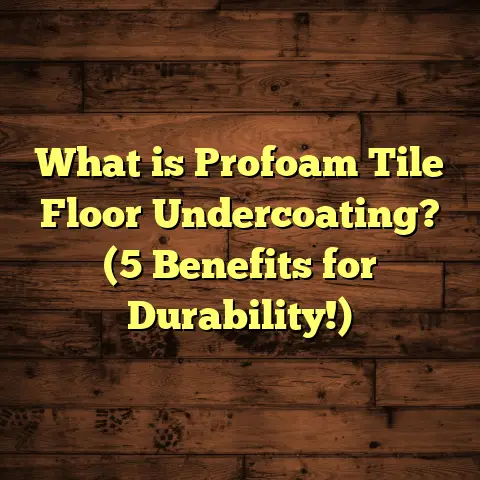What is Pergo Flooring vs Linoleum? (5 Key Differences Explained)
I still remember the day I was knee-deep in a flooring project for a friend’s home when the question came up: “Should I go with Pergo flooring or linoleum?” It seemed simple at first because both were budget-friendly options and had some overlap in terms of use. But as I started explaining the differences, I realized how often people confuse these two or don’t fully understand what they’re getting into. That moment got me thinking—how many others are making decisions without clear info? So today, I want to share everything I’ve learned from years of hands-on experience, countless installs, and research about Pergo flooring versus linoleum. We’ll break down what each is, how they differ, and which situations call for one over the other.
What Is Pergo Flooring and What Is Linoleum?
Before we get into the nitty-gritty, let’s clarify what these two flooring options really are.
Pergo Flooring: More Than Just Laminate
When someone says “Pergo,” they usually mean laminate flooring because Pergo was the pioneer brand that popularized this type of floor back in the late 1970s. The name stuck so well that many people use “Pergo” like a generic term for laminate flooring. But what exactly is it?
Pergo flooring is a multi-layered product. The core component is a high-density fiberboard (HDF) or medium-density fiberboard (MDF) made from wood fibers compressed under heat and pressure. On top of that core sits a photographic layer that shows a realistic image of hardwood, stone, tile, or other patterns. To protect that image and provide durability, a melamine resin wear layer covers everything. This top layer is tough and scratch-resistant, making Pergo floors popular in busy homes.
Laminate flooring like Pergo is usually installed as a floating floor, meaning the planks snap together and aren’t glued or nailed down to the subfloor. This makes installation faster and sometimes DIY-friendly.
Linoleum: A Classic Natural Floor
Linoleum has been around for over a century—yes, it’s one of the oldest resilient floorings still used today. It’s made from natural raw materials:
- Linseed oil (from flax plants)
- Cork dust
- Wood flour
- Rosin
- Pigments for color
- Jute or canvas backing
All these ingredients are mixed and pressed into sheets or tiles. Because it’s made from natural materials, linoleum is biodegradable and considered an environmentally friendly choice.
Unlike laminate, linoleum has a softer feel underfoot and a matte finish with subtle texture. It’s known for its longevity when maintained properly—some commercial linoleum floors have lasted 30 to 40 years.
1. Material Composition and Environmental Considerations
This is where the two floors start to part ways in a big way.
What’s Inside Makes a Difference
I’ve learned that material composition isn’t just about what goes into making the floor—it affects everything from durability to indoor air quality to environmental impact.
Pergo Flooring Composition:
- Core: High-Density Fiberboard (HDF) made from wood fibers and resin.
- Design Layer: High-resolution photographic film giving the floor its appearance.
- Wear Layer: Melamine resin providing protection against scratches and stains.
- Backing Layer: Moisture-resistant material to prevent warping.
Because of resins and plastics used in making Pergo flooring, it’s not biodegradable. But the manufacturing process has improved over time with many brands reducing VOC emissions to make it safer indoors.
Linoleum Composition:
- Linseed oil acts as a natural binder.
- Cork dust and wood flour add strength and resilience.
- Natural pigments provide color.
- Jute or canvas backing gives flexibility.
Linoleum’s renewable ingredients mean it doesn’t release harmful chemicals after installation. Plus, when it reaches end-of-life, it breaks down naturally without polluting landfills.
Environmental Impact—Which Floor Is Greener?
If you want my honest take from working on eco-friendly projects, linoleum is the clear winner for sustainability.
A 2021 study by the European Resilient Flooring Manufacturers Institute found that linoleum’s carbon footprint is about 60% lower than synthetic flooring options like laminate or vinyl. Plus, linoleum absorbs CO2 during manufacture thanks to its natural oils—a neat fact many people don’t know.
Pergo flooring does have some eco-conscious options now. Some manufacturers recycle wood fibers or use low-emission adhesives during installation. But overall, linoleum beats it on natural content and biodegradability.
2. Durability and Wear Resistance: How Long Will Your Floor Last?
Durability usually tops the list of questions I get from homeowners, especially those with kids, pets, or heavy foot traffic areas.
Scratch & Impact Resistance
Pergo Flooring:
The melamine wear layer is engineered to resist scratches from shoes, pet claws, furniture movement, and dropped items. For example, Pergo offers products with an AC rating system that measures durability:
- AC3 is good for moderate residential use.
- AC4 suits heavier residential or light commercial use.
- AC5 can handle high commercial traffic.
Many Pergo floors also have water-resistant cores to prevent damage from spills or moisture—though standing water for hours should still be avoided.
Linoleum:
Linoleum is softer underfoot but can dent if heavy objects drop on it. Scratches are less common but can happen with sharp items.
The natural oils in linoleum help resist bacteria and mold growth—a plus for kitchens or bathrooms—but maintenance like waxing is needed to keep the surface looking fresh.
Longevity in Real Life
I once inspected floors in a daycare center where both Pergo laminate and linoleum were installed in different rooms. The Pergo floors showed minimal wear after 8 years despite heavy use. The linoleum floors had some surface dulling but no major damage after 10 years thanks to regular polishing.
Linoleum can last decades if cared for properly; Pergo tends to have a lifespan of 15-30 years depending on quality and care.
3. Installation: DIY Friendly or Pro Required?
I’ve installed both types multiple times and can tell you upfront—they don’t install the same way at all.
Installing Pergo Flooring
When I helped my cousin redo his living room with Pergo planks, we finished in two days without specialized tools.
Why? Because Pergo uses a click-lock system where planks snap together over an underlayment—no glue or nails required. This floating installation reduces mess and allows for expansion gaps that handle changes in humidity.
You can install Pergo over many surfaces including concrete slabs (with proper moisture barriers), plywood subfloors, and even existing vinyl floors if they’re smooth.
Installing Linoleum
Installing linoleum requires more prep work. With sheet linoleum, you need to:
- Make sure the subfloor is perfectly smooth.
- Cut sheets precisely to fit edges without gaps.
- Use adhesive glue evenly to avoid bubbles or lifting.
- Roll out seams carefully to prevent visible lines.
Tiles can be loose-laid but gluing is preferred for durability.
Because of these challenges, professional installation is usually recommended unless you have experience with flooring glue and cutting tools.
4. Aesthetic Variety and Design Flexibility
Let’s talk looks—because style matters just as much as function for most people I work with.
How Pergo Shows Off Style
Pergo laminate is famous for replicating real hardwood floors at a fraction of the price. Thanks to high-resolution photographic layers, you can find planks that mimic:
- Oak (whitewashed or natural)
- Walnut
- Hickory
- Exotic woods like bamboo or teak
- Stone textures like slate or marble
Some lines offer hand-scraped textures or bevel edges that add depth and realism.
The finish can range from high-gloss for modern kitchens to matte for rustic vibes.
Linoleum’s Classic Appeal
Linoleum is less about pretending to be wood or stone; it’s about its own unique look.
You’ll see:
- Solid colors in muted earth tones like olive green, mustard yellow, rusty reds.
- Marbled patterns blending multiple colors for vintage charm.
- Geometric patterns popular in retro designs.
Its matte surface adds warmth and softness underfoot that laminate lacks.
One client chose linoleum specifically because she wanted her kitchen floor to feel cozy and authentic rather than shiny or artificial-looking.
5. Cost Comparison and Long-Term Value
Money talks—and I always encourage clients to think about both upfront cost and ongoing expenses.
How Much Does Each Cost?
Here’s what I’ve seen recently in pricing across various projects:
| Flooring Type | Material Cost (per sq ft) | Installation Cost (per sq ft) | Total Approximate Cost (per sq ft) |
|---|---|---|---|
| Pergo | $2 – $5 | $1.50 – $3 | $3.50 – $8 |
| Linoleum | $3 – $6 | $2 – $5 | $5 – $11 |
Pergo tends to be cheaper upfront primarily because installation is simpler and quicker.
Maintenance Expenses Over Time
Linoleum requires periodic waxing/polishing to keep its surface protected which adds labor or product costs over time—typically every 1-3 years depending on traffic.
Pergo doesn’t need waxing but may need replacement sooner if damaged beyond repair since it can’t be sanded like hardwood.
Resale Value Impact
From my experience helping homeowners sell their properties:
- Well-installed Pergo floors can add appeal because they look like hardwood but cost less.
- Linoleum may not boost resale value as much but appeals strongly in niche markets focused on sustainability or vintage design.
Additional Insights From My Projects
Over the years, I’ve gathered a few stories that illustrate how these differences play out in real life.
Case Study: Family Home with Active Kids
One family chose Pergo floors for their open-concept living room and kitchen because their toddlers were always dropping toys and spilling juice. They wanted something tough yet affordable. After three years of heavy use, the floors still look great with no scratches or stains thanks to the wear layer’s resistance.
They also appreciated how easy it was to clean compared to carpet or hardwood—just sweeping and damp mopping did the trick.
Case Study: Artist’s Studio Choosing Linoleum
An artist friend wanted her studio floor to reflect her eco-friendly lifestyle. She picked linoleum because she loved its natural materials and soft feel underfoot during long painting sessions.
She maintains it by waxing every year but says it adds character as it ages with subtle color changes she finds beautiful—not something you get with synthetic floors.
Frequently Asked Questions About Pergo vs Linoleum
I often get these questions when chatting with clients:
Q: Can linoleum be used in bathrooms?
A: Yes! Linoleum is naturally water-resistant due to linseed oil but needs sealing around edges to prevent water seepage underneath. It’s softer than tile so more comfortable but not ideal if there’s constant standing water.
Q: Is Pergo waterproof?
A: Most Pergo products are water-resistant but not fully waterproof. Spills should be cleaned quickly to avoid swelling of the fiberboard core.
Q: Which floor feels warmer?
A: Linoleum feels warmer underfoot because of its softer texture and insulating cork content. Pergo can feel cooler since it mimics wood but has a hard top layer.
Q: Can I install either floor over radiant heating?
A: Both can work over radiant heat systems if manufacturer guidelines are followed carefully regarding temperature limits. Linoleum generally handles heat well due to its natural materials; some laminates warn about heat damage so check specs first.
Final Thoughts Based on My Experience
Choosing between Pergo flooring and linoleum comes down to your lifestyle, values, budget, and design goals. Both floors serve important roles in homes today but shine in different ways:
- Pergo flooring offers durability, style variety, ease of installation, and excellent scratch resistance at an affordable price point.
- Linoleum provides a natural product with eco benefits, soft comfort underfoot, timeless aesthetic appeal, but needs more maintenance effort.
If you want low maintenance with lots of style options for high traffic rooms—Pergo is your buddy. If you want an environmentally conscious choice with classic looks that age gracefully—linoleum may win your heart.
Whatever you pick, understanding these five key differences will help you make an informed choice you’ll feel great about down the road.
Feel free to ask me anything else about flooring—I love sharing stories from the trenches!





